Editors note: This blog was originally published in October 2013, and has been completely revamped and updated for accuracy, relevancy, and comprehensiveness in September 2019
Prior to the 17th century, data visualization existed mainly in the realm of maps, displaying land markers, cities, roads, and resources. As the demand grew for more accurate mapping and physical measurement, better visualizations were needed.
In 1644, Michael Florent Van Langren, a Flemish astronomer, is believed to have provided the first visual representation of statistical data. The one-dimensional line graph below shows the twelve known estimates at the time of the difference in longitude between Toledo and Rome as well as the name of each astronomer who provided the estimate. What is notable here is that while Van Langren could have provided this information in a table, it is the use of the graph that really visually displays the wide variations in estimates.

The 18th century saw the beginning of thematic mapping. Attempts at the thematic mapping of geologic, economic, and medical data were made near the end of the century. Abstract graphs of functions, measurement error, and collection of empirical data were introduced at this time.
This period also gave us William Playfair, who's widely considered to be the inventor of many of the most popular graphs we use today (line, bar, circle, and pie charts). Many statistical chart types, including histograms, time series plots, contour plots, scatterplots, and others were invented during this period. A graph by Playfair (1821), shown below, shows the price of wheat, weekly wages, and reigning monarch over a two hundred fifty year span from 1565 to 1820.
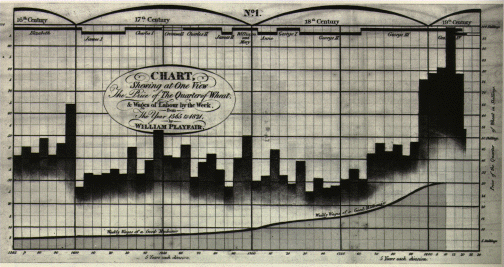
The latter half of the 19th century is what Friendly calls the Golden Age of statistical graphics. Two famous examples of data visualization from that era include John Snow’s (not that Jon Snow!) map of cholera outbreaks in the London epidemic of 1854 and Charles Minard’s 1869 chart showing the number of men in Napoleon’s 1812 infamous Russian campaign army, with army location indicated by the X-axis, and extreme cold temperatures indicated at points when frostbite took a fatal toll.
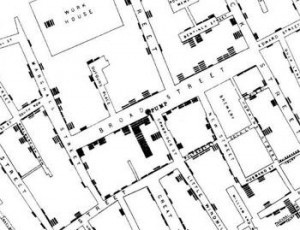
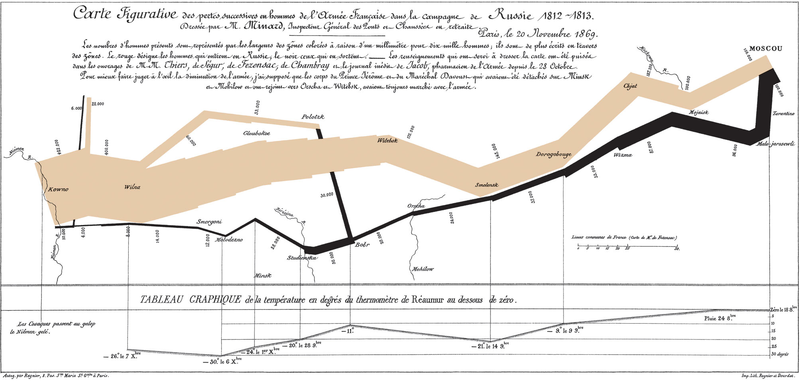
This time also provided us with a new visualization, the Rose Chart, created by Florence Nightingale.
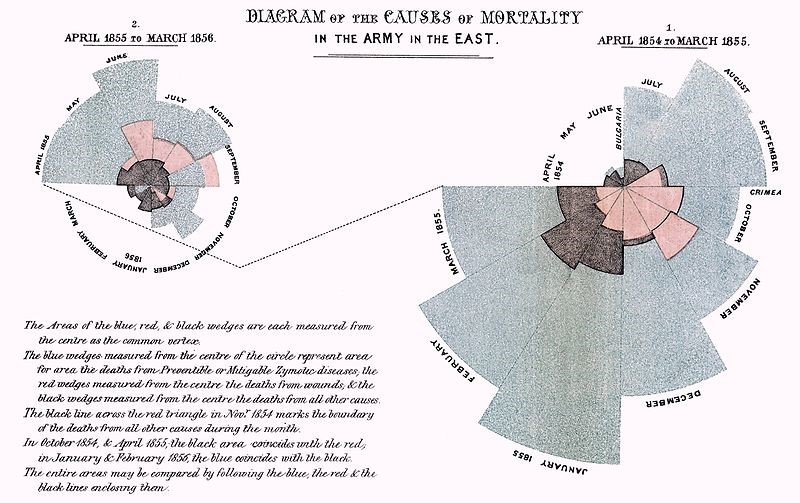
A number of factors contributed to this “Golden Age” of statistical graphing: the industrial revolution, which created the modern business; official government statistical offices, to support an increasingly aware and global populace; and a growing recognition for the importance of numerical data in social planning, medicine, military, industrialization, commerce, and transportation. Statistical Theory also provided the means to make sense of large datasets.
The growing trend towards statistical visualizations hit a small roadblock in the early 20th century. Friendly describes this era as the modern dark ages for data visualization. Statisticians were increasingly concerned with exact numbers, and consider images to be overly inaccurate. While innovation in the field may have indeed veered away from data visualizations, this period saw a growth of data visualization in the public consciousness. Charts and graphs of various sorts were rapidly becoming adopted into textbooks, business applications, science, and government.
[Editor’s Note: While statisticians gave data visualization the cold shoulder during this era, the first half of the 20th century also brought psychology forward as a science; in particular, the development of cognitive psychology and the study of human perception has provided a much better understanding as to how the brain interprets information and recognizes patterns. This research has been instrumental in developing and refining the science of data visualization best practices.]
The latter half of the 20th century is what Friendly calls the ‘rebirth of data visualization’, brought on by the emergence of computer processing. Computers gave statisticians the ability to collect and store data in increasingly larger volumes, as well as the ability to visualize the information quickly and easily. The 1960s and 1970s saw the emergence of researchers like John W. Tukey in the United States and Jacques Bertin in France, who developed the science of information visualization in the areas of statistics and cartography, respectively. The early 80s saw the emergence of Edward Tufte, whose seminal work, The Visual Display of Quantitative Information is still used today in university courses for data visualization and statistical analysis. Tufte also introduced us to the sparkline, which gives the general shape of a trend in a small amount of space.
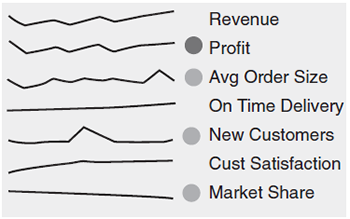
The last three decades have seen the field of data visualization explode into dozens and even hundreds of focus areas. Dashboards and data discovery tools, scorecard applications, analytics suites, and an assortment of other software tools enable businesses, researchers, and individuals to explore their data in new and increasingly imaginative ways. Notable writers and educators in the modern era, including Alberto Cairo, Stephen Few, and Colin Ware, continue to refine the science and art of data visualization and bring it to new heights.
We live in an exciting yet challenging time for data visualization. Even as we discover new ways to collect, aggregate, analyze and visualize data, we are also discovering some new and important societal challenges regarding the violation of privacy and the potential misuse of data – both intentional and unintentional. As we enter the information age, it’s both exciting and terrifying to imagine what the future holds in store for us, both as individuals and as a society. Randy Bachman said it best: We ain’t seen nothin’ yet!


Follow Us
Support